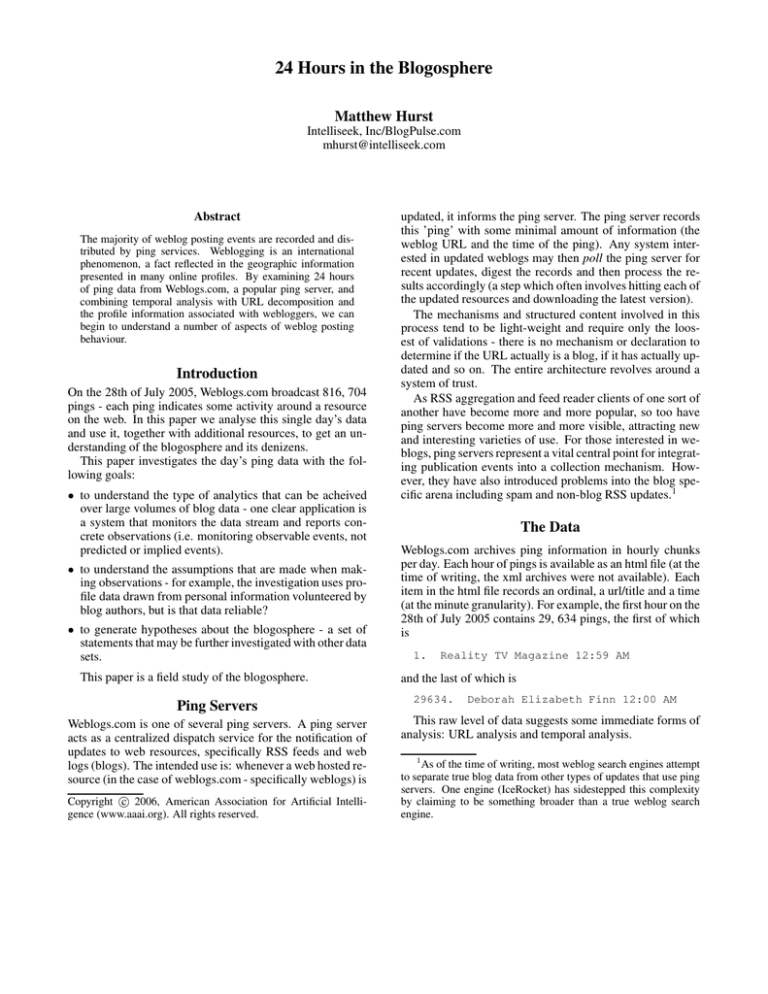
24 Hours in the Blogosphere
Matthew Hurst
Intelliseek, Inc/BlogPulse.com
mhurst@intelliseek.com
Abstract
The majority of weblog posting events are recorded and distributed by ping services. Weblogging is an international
phenomenon, a fact reflected in the geographic information
presented in many online profiles. By examining 24 hours
of ping data from Weblogs.com, a popular ping server, and
combining temporal analysis with URL decomposition and
the profile information associated with webloggers, we can
begin to understand a number of aspects of weblog posting
behaviour.
Introduction
On the 28th of July 2005, Weblogs.com broadcast 816, 704
pings - each ping indicates some activity around a resource
on the web. In this paper we analyse this single day’s data
and use it, together with additional resources, to get an understanding of the blogosphere and its denizens.
This paper investigates the day’s ping data with the following goals:
• to understand the type of analytics that can be acheived
over large volumes of blog data - one clear application is
a system that monitors the data stream and reports concrete observations (i.e. monitoring observable events, not
predicted or implied events).
• to understand the assumptions that are made when making observations - for example, the investigation uses profile data drawn from personal information volunteered by
blog authors, but is that data reliable?
• to generate hypotheses about the blogosphere - a set of
statements that may be further investigated with other data
sets.
This paper is a field study of the blogosphere.
Ping Servers
Weblogs.com is one of several ping servers. A ping server
acts as a centralized dispatch service for the notification of
updates to web resources, specifically RSS feeds and web
logs (blogs). The intended use is: whenever a web hosted resource (in the case of weblogs.com - specifically weblogs) is
c 2006, American Association for Artificial IntelliCopyright gence (www.aaai.org). All rights reserved.
updated, it informs the ping server. The ping server records
this ’ping’ with some minimal amount of information (the
weblog URL and the time of the ping). Any system interested in updated weblogs may then poll the ping server for
recent updates, digest the records and then process the results accordingly (a step which often involves hitting each of
the updated resources and downloading the latest version).
The mechanisms and structured content involved in this
process tend to be light-weight and require only the loosest of validations - there is no mechanism or declaration to
determine if the URL actually is a blog, if it has actually updated and so on. The entire architecture revolves around a
system of trust.
As RSS aggregation and feed reader clients of one sort of
another have become more and more popular, so too have
ping servers become more and more visible, attracting new
and interesting varieties of use. For those interested in weblogs, ping servers represent a vital central point for integrating publication events into a collection mechanism. However, they have also introduced problems into the blog specific arena including spam and non-blog RSS updates.1
The Data
Weblogs.com archives ping information in hourly chunks
per day. Each hour of pings is available as an html file (at the
time of writing, the xml archives were not available). Each
item in the html file records an ordinal, a url/title and a time
(at the minute granularity). For example, the first hour on the
28th of July 2005 contains 29, 634 pings, the first of which
is
1.
Reality TV Magazine 12:59 AM
and the last of which is
29634.
Deborah Elizabeth Finn 12:00 AM
This raw level of data suggests some immediate forms of
analysis: URL analysis and temporal analysis.
1
As of the time of writing, most weblog search engines attempt
to separate true blog data from other types of updates that use ping
servers. One engine (IceRocket) has sidestepped this complexity
by claiming to be something broader than a true weblog search
engine.
8000
Ping count
178, 128
53, 049
40, 231
38, 516
28, 491
ping counts
7000
6000
5000
Host
http://spaces.msn.com
http://search-now130.com
http://findallarticles.com
http://search-now140.com
http://www.look4articles.com
4000
Table 2: Ping counts per host.
3000
2000
1000
0
0
5
10
15
20
25
30
35
40
45
50
Figure 1: The number of URLs per total pings received by
Weblogs.com
URL Analysis
We first consider the entire URL, theoretically, indicating a unique weblog; secondly, we have domains: important as many blogs are hosted by a service which is
unique at the domain level (e.g. typepad, livejournal, xanga,
blogspot); finally, we have hosts: these are interesting as
many unique blogs are identified by hosts information dynamically mapped to a users blog.
Table 1 shows a breakdown of the number of pings received from individual URLs. 51.74 % of all pings are accounted for by URLs that pinged only once in the 24 hour
period. The highest number of pings was 49, received from
http://neoamin-net.staging.daemon.co.za
Ping Count
1
2
3
4
5
Number of URLs
422, 526
40, 166
14, 737
7, 821
3, 456
% of all pings
51.74
9.84
5.41
3.83
2.12
Table 1: Counts of URLs by number of pings.
If we plot the count of URLs against the number of pings
received, it is not surprising to see rapid decay as the data
in Table 1 suggests. What is notable is that when the details
of the tail (shown in Figure 1) are plotted, the decay is not
smooth. In fact, there is a clear spike at the 24 count. This is
the first trace that we see of non-human posting mechanisms
at work. A random sample of 100 URLs taken from the
total of 503, 187 URLs and hand labeled resulted in 54 %
spam blogs. Clearly, Weblogs.com is a highly compromised
service.
Table 3 shows the pings per domain, the URLs for each
domain and the ratio of pings per URL - the average number of pings from URLs in the domain. The majority of
domains average between 1 and 2 pings per URL, something that we might believe is normal posting behaviour.
Only five of those domains listed have ping ratios above 2.0:
Domain
blogspot.com
msn.com
search-now130.com
findallarticles.com
search-now140.com
look4articles.com
findactions.com
myblog.de
find4news.com
livejournal.com
wefindforyou.com
blogdrive.com
persianblog.com
blogspirit.com
blogfa.com
hautetfort.com
typepad.com
cocolog-nifty.com
livedoor.jp
obtainamazing.info
pings
262, 702
178, 128
53, 049
40, 231
38, 516
28, 491
23, 054
13, 537
13, 378
6, 509
5, 972
3, 734
3, 400
3, 162
2, 979
2, 851
2, 720
2, 540
2, 228
1, 920
URLs
62, 012
146, 917
53, 041
40, 225
38, 509
28, 478
23, 049
5, 281
13, 375
3, 919
4, 472
2, 604
2, 547
568
2, 231
312
1, 627
2, 001
1, 350
719
ratio
4.24
1.21
1.00
1.00
1.00
1.00
1.00
2.56
1.00
1.66
1.34
1.43
1.33
5.57
1.34
9.14
1.67
1.27
1.65
2.67
Table 3: Ping counts and number of unique URLs per domain.
blogspot.com, myblog.de, blogspirit.com, hautetfort.com
and obtainamazing.info.
Temporal Analysis
If we plot the pings per minute for some of the top ranked
domains, we can observe some remarkable differences. Figure 2 contains two time plots. The first compares Blogspot
and Spaces and the second compares search-now130 and
findallarticles. In the first, we can observe a strong trend
which peaks around minute 650 (approximately 11 am). Intuitively, we might describe this pattern as a natural pattern
of blog posting and make the following hypothesis:
HYP 1: Bloggers post at a steady rate throughout the
day with a surge around 11 am as well as a lesser surge
approaching midnight.
Further analysis, including the inclusion of location information pulled from profiles will modify this hypothesis
considerably.
If we compare this strong ‘natural’ trend with the flat
trend shown in the second graph in Figure 2 we arrive at
a further hypothesis:
800
70
blogspot
spaces
700
search-now130
findallarticles
60
600
50
500
40
400
30
300
20
200
10
100
0
0
200
400
600
800
1000
1200
1400
0
0
200
400
600
800
1000
1200
1400
Figure 2: Pings per minute for Blogspot and Spaces (left) and pings per minute for search-now130 and findallarticles (right).
HYP 2: In aggregate, bloggers post in predictable but
non-uniform patterns throughout the day.
In other words, humans look like humans and robots look
like robots.
The variance in post counts per minute for Blogspot and
Spaces is further analysed in Figure 3 which clearly illustrates the fact that Blogspot has a wide variance compared
with that of Spaces. This leads to another hypothesis regarding the temporal profile of hosted blogs:
HYP 3: Variance in posts counts per minute for a
hosted blog system is correlated with the percentage
of spam blogs hosted by that system.
250
90
china
united states
80
70
60
50
40
30
20
10
0
0
200
400
600
800
1000
1200
1400
Figure 4: Ping times for China and United States Space
bloggers
spaces
blogspot
200
150
100
50
0
0
100
200
300
400
500
600
700
800
Figure 3: Distribution of pings per minute for Spaces and
Blogspot.
Profile Analysis
The previous two sections have looked at analytical possibilities and results for the object data provided by Weblogs.com. In what follows, we use information drawn from
blog profiles to segment the data by a number of features.
Before presenting this analysis, we first give a brief introduction to blog profiles and how the information is captured.
Most blog hosting systems require or allow the user to
register certain types of profile information. This often includes name, age, gender and location. The author may elect
to have this information displayed, in which case it may appear in one or more places including the blog itself and a
special profile or about-me page.
As the information is generally of a simple key-value pair
type, the presentation is often a simple highly structured part
of the page. To extract this information, we use a method
called automated wrapper induction (similar in motivation to
supervised methods such as (CHJ02), (Bre03)). The specific
technique is not described in detail here, but briefly it:
• collects all the text nodes in an html document and represents them using a combination of tag path (representing
structural and presentational tags in different spaces) and
text features,
• groups text nodes that are ‘similar’ according to a measure
based on the tag path representation,
• clusters sequences of text nodes drawn from groups of
similar nodes.
The results of this system are filtered by text strings
Feature
Location
Age
Occupation
Spaces
119, 954 (81.65 %)
83, 327 (56.72 %)
20, 403 (13.89 %)
Blogspot
21, 304 (34.26 %)
12, 462 (20.14 %)
11, 830 (19.03 %)
Table 4: Profile feature yields for Spaces and Blogspot.
8000
blogspot
spaces
7000
6000
5000
4000
that are strong indicators of profile information, such as
gender, age and so on.
By running this system within a simple crawl that either
passes the blog front page or looks for a known profile page
(e.g. in the case of blogspot it searches for a link in a particular location on the page) we can derive profile data for
many of the bloggers in the data set.
Extracting Profile Information from Weblogs
When extracting features from profiles, some criteria are
needed for determining whether or not the value found is
good or not. For these experiments we used some very simple tests. For location and occupation, a valid field simply
had to have some text in it. For age, the field had to contain a sequence of numbers. Of course, there is some risk
in this apprach, particularly for location and occupation values. Some percentage of values will be good locations, for
example, including country, state and metro names. Others will include some amount of unconventional material
(Location: la la land). This study does not aim
to resolve this issue, but we note the problem.
Table 4 presents the counts of values retrieved from the
profile harvest. It shows that for location and age, Spaces
provides more data than Blogspot. Occupation shows the
reverse with Blogspot having a greater share.
HYP 4: Different hosting systems either attract users
more likely to disclose personal information or are better at eliciting this type of information.
HYP 5: Blogspot users are more disposed to provide
occupation information than Spaces users.
Table 5 shows the break down of Spaces and Blogspot
bloggers by country. The values used to segment that data
are not strictly interpretations of the text found in the relevant profile fields. Rather, they are the last element of
that field and therefore an object level string. This breakdown relies on the most common structure of these entries
which presents metro, state and country level information. It
should be noted that there are some cases where a country
is not given, but where other information is provided from
which a country could be inferred (e.g. New York).
The two tables show the top 20 countries by count for
Spaces and Blogspot. The third column shows how many
of these also provided age information. The next column
shows the average age and the final column shows the per
capita of bloggers as bloggers per million of population.
A broad comparison lets us see that
• the average age of Spaces bloggers is less than that of
Blogspot bloggers.
3000
2000
1000
0
0
20
40
60
80
100
120
Figure 5: Age distribution in Blogspot and Spaces.
• the ranking of countries is considerably different, for
example for Spaces china is ranked first whereas for
Blogspot it isn’t even in the top 20.
In addition, Table 5 shows the percentages of bloggers in
each system who registered location information who also
registered age. For example, 90.33 % of bloggers in Spaces
that registered the location mexico also registered an age.
HYP 6: There is a relationship between the location of
a blogger and the service that they use.
Finally, Table 5 shows the per capita of bloggers for each
system by country. This value is per million of population.
For example, 30.30 per million Chinese registered at Spaces
and declared their location to be China. There are some very
interesting outliers in this data. Taiwan, for example, has
472.95 per million capita in Spaces, compared with 40.53
for the United States.
HYP 7: Asian countries have a higher blogger per
capita ratio.
Combining Temporal and Geographic
Features
Figure 4 plots the pings per minute for bloggers using
Spaces from China and those from the United States. As
the time is normalized to some US time what we see as a
large peak in the centre for China is actually bloggers blogging around midnight. In contrast, the US bloggers hit their
stride in the run up to lunch time and don’t let up until the
wee hours. This analysis contests HYP 1 describing a general distribution of blogger ping times. In fact, projecting
this sample onto the overall trend, we might hypothesise the
total percentage of users from China based on the dominance
of the peak around US noon. In fact, Figure 7 suggests that
the main peak of activity in the US is around midnight, further supporting the explanation of the Chinese influence on
the dominant peak found in Figure 2.
Figure 5 shows the distribution of ages in Blogspot and
Spaces. The average age in Blogspot is 29.19, and the average for Spaces is 22.04. The average age for United States
bloggers in Blogspot is 30.57. The average age for Chinese
bloggers in Spaces is 21.76.
Country
china
united states
taiwan
japan
brazil
united kingdom
canada
australia
spain
mexico
france
italy
hong kong sar
thailand
netherlands
argentina
peru
belgium
chile
portugal
india
singapore
philippines
malaysia
germany
sweden
Spaces
Count w/Age
39, 584
62.60
11, 985
69.64
10, 828
65.40
7, 436
54.57
5, 817
71.67
4, 928
76.95
4, 483
77.52
4, 454
74.00
3, 785
79.34
3, 259
90.33
2, 296
80.31
2, 212
86.93
2, 029
61.46
1, 672
76.61
1, 368
81.36
1, 265
85.53
675
80.00
577
81.98
569
78.73
565
79.82
154
621
0
450
561
262
69.48
64.73
0
77.56
79.32
77.10
age
¯
21.76
21.02
22.29
23.58
22.38
20.01
22.37
20.22
20.84
20.56
25.22
21.34
21.98
20.78
28.81
21.55
20.98
27.51
22.10
23.45
per cap
30.30
40.53
472.95
58.36
31.26
81.53
136.66
221.70
93.82
30.69
37.85
38.07
294.11
25.55
83.38
31.99
24.17
55.67
35.60
53.47
Country
united states
canada
united kingdom
india
portugal
australia
brazil
singapore
malaysia
mexico
spain
chile
philippines
argentina
taiwan
france
germany
japan
sweden
netherlands
26.63
20.72
0
21.10
21.96
29.62
0.14
140.32
0
18.79
6.8
29.11
china
italy
hong kong
thailand
peru
belgium
Blogspot
Count w/Age
9, 427
56.17
1, 170
58.21
913
57.61
561
67.20
522
62.26
478
58.16
470
67.66
460
72.82
445
67.42
434
57.37
420
67.86
274
76.64
267
73.78
232
68.54
187
66.84
184
61.96
172
58.72
169
52.07
164
63.41
162
70.37
47
98
158
43
51
64
63.83
66.33
46.20
60.47
70.59
75.00
age
¯
30.57
29.87
30.02
25.02
30.92
27.50
27.10
24.28
23.68
25.07
29.78
27.99
24.86
28.14
26.67
30.78
29.61
30.00
28.39
33.25
per cap
31.88
35.67
15.11
0.52
49.40
23.79
2.52
103.94
18.58
4.09
10.41
17.15
3.04
5.87
8.17
3.03
2.09
1.33
18.22
9.87
24.43
29.48
22.17
26.88
28.39
31.83
0.04
1.69
22.90
0.66
1.83
6.17
Table 5: Geographic distribution for Spaces and Blogspot bloggers. For each host, the top 20 locations are listed. Each table is
augmented with an addition 6 locations to make complete comparison posisble.
HYP 8: There is a relationship between the age of a
blogger and the service that they use.
3500
china
japan
taiwan
united states
brazil
3000
Conclusions
This paper has investigated a number of facets of bloggers, their publishing behaviour and the mechanisms used to
broadcast publication. It has highlighted a number of potentially significant variations across factors such as the hosting
system, the registered location of the blogger and the registered age of the blogger.
2500
References
2000
Thomas Breuel. Information extraction from html documents by structural matching. In Second International
Workshop on Web Document Analysis, 2003.
William Cohen, Matthew Hurst, and Lee Jensen. A flexible
learning system for wrapping tables and lists in html documents. In Proceedings of International WWW Conference
(11), 2002.
1500
1000
500
0
0
20
40
60
80
100
120
Figure 6: Age distribution in Spaces for different countries.
Figure 6 shows the distribution of ages for the top 5 countries in the Spaces segment. It illustrates the clear differences between countries. This kind of data has relevance
for systems that aim to infer demographic information about
bloggers.
HYP 9: There is a relationsconthip between the location of a blogger and the age of the blogger.
1000
brazil
united states
argentina
mexico
canada
900
800
700
600
500
400
300
200
100
0
0
5
10
15
20
Figure 7: Pings per hour for a selection of American countries.
Figure 7 shows pings per hour for Space blogs for a selection of countries in the American continent. There appears
to be three classes of patterns here. Firstly, as for Argentina
and Mexico, a relatively flat trend with a dip in the nught;
secondly, as for Brazil, a more curved trend with a dip at
night; thirdly, as for the US and Canada, a peak or plateau
followed by a second burst late at night followed by the later
dip common to all.
HYP 10: There are different patterns to blog posting
that are culturally dependant.





